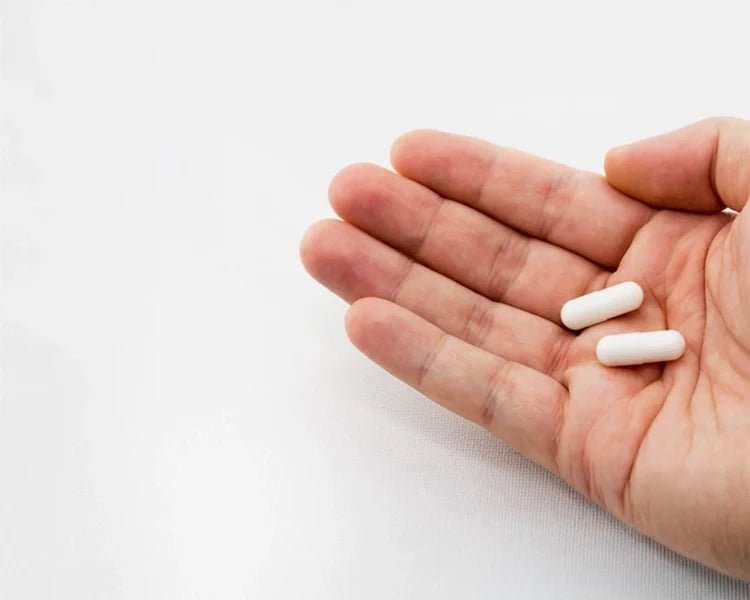Education
Medicine or dietary supplement? What to choose?
Mr. Magister, I would like some magnesium "in the form of a MEDICINE". A conversation at the pharmacy window often begins with this phrase. Then the patient begins a long analysis of the composition and packaging to be 100% sure that there is no inscription "dietary supplement" on it. The pharmacist often avoids talking about this topic, but should still be prepared to talk to the patient. The problem of distinguishing and comparing drugs and dietary supplements is quite difficult. Both product categories are placed on adjacent stands and have similar, and often the same, composition. So what is the mystery and why do patients try so hard to buy a drug and not a dietary supplement? Let's start with individual definitions. A medicinal product is a substance or mixture of substances presented as having properties for the prevention or treatment of diseases occurring in humans or animals or administered for the purpose of making a diagnosis or for the purpose of restoring, improving or modifying the physiological functions of the body through pharmacological, immunological or metabolic action. (Pharmaceutical Law of September 6, 2001, Chapter 1 Art.2 Point 32.) The definition contained in the Act clearly states that a drug (medicinal product) prevents, cures, improves or modifies the physiological functions of the body. Whereas: Dietary supplement - a food intended to supplement a normal diet, being a concentrated source of vitamins or minerals or other substances having a nutritional or other physiological effect, single or combined, placed on the market in a form enabling dosing, in the form of: capsules, tablets, dragees and in other similar forms, sachets with powder, ampoules with liquid, dropper bottles and other similar forms of liquids and powders intended for consumption in small, measured unit quantities, excluding products having the properties of a medicinal product within the meaning of the provisions of pharmaceutical law. (UST AWA of August 25, 2006 on food and nutrition safety, SECTION I, Art. 3 point 3, ppk39) According to this definition, a dietary supplement is a food that is intended to supplement the normal diet with vitamins, minerals and "other" substances. At first glance you can see the difference, but is it really? Looking at the last part of the definition: excluding products with the properties of a medicinal product within the meaning of pharmaceutical law, we reach the point where it is impossible to distinguish a dietary supplement from a drug. What is the difference between a medicinal product containing 2000 IU of vitamin D3 in the form of cholecalciferol and a dietary supplement containing exactly the same in the same form, but in capsules? There are several differences between a drug and a dietary supplement, but neither side achieves a clear competitive advantage. The first issue concerns legal aspects. Various institutions register both product groups. Drug registration is handled by URL (Drug Registration Office). It does this on the basis of many tests and certificates. However, the Chief Pharmaceutical Inspector is responsible for marketing authorization in the country. Dietary supplements are also officially registered by the Chief Sanitary Inspector (GIS) on the basis of an application submitted by the entrepreneur. Therefore, it is not the law that supplements are not subject to control, because the GIS may refuse to register or, in case of uncertainty, may ask for an opinion from the URL. The registration procedure for dietary supplements is shorter and easier to carry out, which is why many drug manufacturers register their next products in this category. The second thing is the doses of individual ingredients. Based on the dose definitions, substances in a drug have a curative or preventive effect, while in a supplement they have a nutritional effect. No less surprising is the fact of the existence of vitamin C - a drug in doses of 200 and 500 mg in the presence of the same vitamin - a supplement in doses of 1000 and 2000 mg. Questions arise about the body's actual needs, the dose that produces a therapeutic or nutritional effect, and the dose that is too high to be safe. Another aspect concerns the origin of the ingredients contained in the products. Due to high standardization requirements and the purity of substances, synthetic substances obtained through chemical reactions are often used in medicinal products. Dietary supplements often contain ingredients of natural origin, which seems to be a healthier solution and more adapted to the living organism. They also contain plant ingredients and their extracts. Sometimes dietary supplements contain plant ingredients that are not found in our climate or in Europe, but which have a proven positive effect on health and fitness. Further differences concern promotion and advertising. No elements of the packaging, names or advertising of supplements may suggest medicinal properties. Each package must also have the description "DIETARY SUPPLEMENT". Every day we are attacked by advertisements for medicines and supplements, so much so that it is difficult to know what and whether it is worth buying to support our health. We consume large amounts of medicines and dietary supplements every day. This is due to the fact that the availability of supplements is very high, advertising in the media is intense, and society is taught to respond to changes in its health by purchasing new preparations. Supplements are used to improve the condition of hair, nails, skin, eyes, joints, etc. We supplement vitamins, minerals and herbs using multi-ingredient products. Therefore, it is important to know the exact composition of a given preparation. There is a high probability that several preparations will contain the same ingredients and by taking a whole range of products we will provide too high doses of the mentioned vitamins or minerals. It is also worth remembering that the most important source of supplementation is food, i.e. what we eat. So how should you approach the use of supplements to make it safe? Let us remember that choosing a drug as a safe form will not always meet the nutritional and health needs of the body. On the other hand, not all supplement manufacturers meet the quality standards of their products. Taking this summary into account, you should follow a few rules to achieve the appropriate nutritional effect while maintaining safety. Here are the rules worth following Let's choose high-end supplements - there are several leading companies on the market. Some of them can be found on our website. Companies with extensive experience, certified products and production standards such as GMP, ISO, etc. The most advantageous offers are provided by companies that grow medicinal herbs themselves and produce vitamin and mineral ingredients instead of mass purchases from suppliers. Let's use only those substances that we need - it's best to discuss the selection of ingredients with a specialist. Do not use supplements recommended by third parties. The appropriate selection of supplements in oncological diseases and post-oncological therapies is extremely important. Many ingredients have the ability to stimulate excessive cell growth. If possible, use single-component or multi-component preparations. We will then avoid the possibility of duplicating doses of the same substance. Let's ask a specialist when and how to take a given product. Often, the absorption of the substance and the effect of the entire preparation depend on the time of day or the meal we take. In light of these assumptions, I believe that the use of dietary supplements can be safe and bring good results. By choosing only medicinal products, we will not achieve long-term effects and visible results. A well-balanced and well-thought-out combination of medicine and dietary supplement can achieve very good results. Let's take the medicines that are necessary for us, let's take the dietary supplements that we need, but let's not forget about proper nutritious food, including fruit and vegetables. Krzysztof Juszkiewicz
Learn moreWhen is it worth visiting a gastroenterologist?
Digestive health plays a key role in an individual's overall health. Our digestive system is not only responsible for the absorption of nutrients, but also plays an important role in the immune system and metabolism. However, its improper functioning can lead to a variety of health problems. Therefore, understanding the importance of digestive health and being aware of signals that may indicate the need to consult a gastroenterologist are extremely important for maintaining full health and well-being. Symptoms that may indicate the need to visit a gastroenterologist are usually related to gastrointestinal problems and can be diverse. Among them stand out: Abdominal pain, which may occur in various places and have a different nature (dull, stabbing, cramping). If the pain persists for a long time or occurs regularly, it may be a sign that there is a problem in the digestive system that requires evaluation by a specialist. Heartburn, i.e. burning or burning sensation in the esophagus and chest area. Its frequent occurrence may indicate gastroesophageal reflux disease, i.e. the reflux of stomach contents into the esophagus, leading to damage to the mucous membrane. Recurrent damage and inflammation predispose to cancer processes, therefore faster diagnosis and initiation of treatment are associated with a better prognosis. Bloating, nausea, vomiting, diarrhea or constipation may indicate various conditions such as irritable bowel syndrome, inflammatory bowel disease, intestinal infections or other digestive disorders. Sudden and unintentional weight loss. If you noticeably lose weight despite maintaining a normal appetite and a healthy lifestyle, this may be a reason to consult a gastroenterologist. Weight loss can be caused by various digestive disorders, such as inflammatory bowel disease, celiac disease, colon cancer or other serious disorders, but cancer can also be the cause. Changes in stool consistency may be an important signal of health problems other than cancer. If continuous diarrhea or constipation is observed, as well as changes in the color, consistency or appearance of the stool, consultation with a gastroenterologist is recommended. This may suggest not cancer but problems such as irritable bowel syndrome, Crohn's disease, ulcerative colitis or other diseases that require diagnosis in a doctor's office. Prevalence of cancer of the digestive system in the family. Separate recommendations for such patients are currently in force and are still being developed. These most often include suggestions for accelerated tests detecting early signals of these diseases and performing an extended panel of genetic tests. Therefore, the presence of cancer or autoimmune diseases in the family should prompt other relatives to take appropriate preventive measures and monitor their health. Environmental factors such as diet, lifestyle, stress factors and infections also play an important role in the occurrence of digestive system cancers. Eating habits and lifestyles may be similar within families, contributing to a similar environment that may promote the development of these conditions. Regular examinations and practicing healthy eating and lifestyle habits can help prevent or detect these diseases early. ATTENTION! If any symptoms occur, it is extremely important not to delay visiting a gastroenterologist. Early recognition and treatment of serious digestive problems, including cancer, can be crucial to continuing to lead a healthy life. Adam Trzciński
Learn moreThe role of physical activity in cancer prevention
Exercise can increase motivation to change lifestyle, improve aerobic capacity, improve physical fitness, control fatigue and improve quality of life [1], and this is just a part of their beneficial effects on the human body at all ages. It is estimated that almost half of cancer cases can be prevented by changing lifestyle, including physical activity [2], which is one of the four pillars of health. In a report by The World Cancer Research Fund (WCRF) published in 2020, the organization indicates that it plays a significant role in cancer prevention [3] . The main benefits of physical activity include regulating body weight, improving the efficiency of the circulatory and respiratory systems, as well as strengthening muscles and bones. Blood flow and tissue oxygenation are also increased, which translates into greater energy and vitality. Additionally, exercise has a real impact on mental health because regular exercise can reduce symptoms of depression, anxiety and stress by releasing hormones that can improve mood and feelings of overall well-being. Physical activity also improves cognitive functions, i.e. memory, concentration and the ability to focus, and significantly increases the quality of sleep by regulating the circadian rhythm. Regular exercise can help you fall asleep faster and enable deeper sleep, and it also lowers blood pressure, reducing the risk of heart disease. The multi-year European Prospective Investigation into Cancer and Nutrition (EPIC) study of over 500,000 people found that regular physical activity was associated with a lower risk of many types of cancer, such as colorectal cancer, breast cancer, pancreas and endometrial cancer [4]. A meta-analysis based on 170 studies confirmed that regular physical activity is associated with a reduced risk of colorectal cancer. It was observed that people engaging in regular physical exercise had a 24% lower risk of developing this type of cancer compared to people leading a sedentary lifestyle [5]. A study published in the British Journal of Cancer and conducted by the European Prospective Investigation into Cancer and Nutrition - EPIC found that regular physical activity can reduce the risk of breast cancer in postmenopausal women. Women who performed at least 7 hours of moderate physical activity per week had a 13% lower risk of developing breast cancer compared to those who were physically inactive [6]. Systematic physical activity, which can be freely chosen from a wide range of possibilities, from walks in nature, through team games, to individual training in the gym, provides great support in cancer prevention. It is a permanent element of a healthy lifestyle, which is modified depending on possibilities, needs and preferences. In addition to the obvious physical benefits it brings, it has a real impact on improving mood and well-being. Its beneficial effect on the body is multidimensional, so it is worth including it permanently in your weekly plan. Zuzanna Pilipiuk Qiaoyun Wang, Wenli Zhou, (2020) Roles and molecular mechanisms of physical exercise in cancer prevention and treatment, J Sport Health Sci. 2021 Mar;10(2):201-210. doi: 10.1016/j.jshs.2020.07.008. Epub 2020 Jul 30. Christine M Friedenreich, Charlotte Ryder-Burbidge, Jessica McNeil, (2021). Physical activity, obesity and sedentary behavior in cancer etiology: epidemiologic evidence and biological mechanisms, Mol Oncol. 2021 Mar;15(3):790-800. doi: 10.1002/1878-0261.12772. Epub 2020 Aug 18. Steven K Clinton, Edward L Giovannucci, Stephen D Hursting, (2020). The World Cancer Research Fund/American Institute for Cancer Research Third Expert Report on Diet, Nutrition, Physical Activity, and Cancer: Impact and Future Directions, Żuławski, W., Rutkowski, A., & Dziki, A. (2015). Influence of physical activity on the risk of colorectal cancer in the population of the European countries. Contemporary Oncology, 19(1), 7-13. Keum, N., & Giovannucci, E. (2019). Global burden of colorectal cancer: emerging trends, risk factors and prevention strategies. Nature Reviews Gastroenterology & Hepatology, 16(12), 713-732. Steindorf, K., Ritte, R., Eomois, P. P., Lukanova, A., Tjonneland, A., Johnsen, N. F., ... & Schütze, M. (2013). Physical activity and risk of breast cancer overall and by hormone receptor status: the European prospective investigation into cancer and nutrition. International Journal of Cancer, 132(7), 1667-1678.
Learn moreNeeds in cancer patients - how to communicate them?
Communication regarding sexual needs in cancer patients is important, but unfortunately often overlooked. There is a false belief that, given the many challenges that cancer brings to a patient, sexuality is one of the last things that should be taken into account. This is absolutely not true - sexual needs are physiological needs and, just like any other, they require satisfaction. Of course, in the course of oncological disease, the possibilities of satisfying sexual needs may (but do not have to) be slightly modified, but this does not mean that the patient's sexual life ceases to be a source of fulfillment and satisfaction [1] . The treatment team has an important role in the process of caring for the well-being of an oncology patient. First of all, it is good practice to create a safe and trusted environment for the patient. The patient should feel comfortable and safe because this is what creates space to open conversations about sexual needs. It is important for the doctor to create an atmosphere of trust so that the patient knows that he is welcome to express his concerns and ask questions about sexuality. It is also good practice for the doctor to initiate a conversation about sexual needs. During such a conversation, it is worth assuring the patient that it is natural to have questions or concerns about the impact of the disease and oncological treatment on the sexual sphere. Open questions will certainly be helpful in such a conversation, as they will allow the patient to express his concerns or describe new experiences [2] . Proactivity is also important - listening carefully to the patient. This creates space to express your emotions, concerns and questions. At this point, it is worth paying attention to how important it is to listen carefully and show interest and understanding. The next step is to provide the patient with the necessary information about possible side effects of treatment, changes in sexual function, and available strategies and resources that can help deal with these challenges. In providing comprehensive care, the cooperation of the entire treatment team is crucial - many different fields of medicine may influence the sexual needs of oncology patients. Patient care can be provided not only by doctors and nurses, but also by psychologists and sexologists and psychotherapists. It is important to provide the patient with comprehensive care to be aware of problems arising during treatment, because this allows the patient to be referred to the appropriate specialist if necessary [3] . Your own work also plays an invaluable role - it is worth encouraging the patient to seek support - your doctor can inform you about available resources and support groups for cancer patients. Self-help groups can be valuable support in dealing with challenges in meeting sexual needs. Support can be received either through individual therapy, through group therapy sessions, or through use from extensive resources conveniently available electronically. Monika Kaszuba [1] Cichosz M., Wieczorek A. (2016), Sexual problems of cancer patients. Roczniki Psychology, 19(2), pp. 167-187 [2] Bębenek M., Czuba B., Pilewska-Kozak A., Wojtyna E. (2015). The impact of cancer on the sexual sphere. Przegląd Menopauzalny, 14(4), pp. 273-278 [3] Sobolewski M., (2018). Sexuality of patients with cancer of the reproductive organs - recommendations of the European Society of Oncology (ESMO) and other scientific societies. Ginekologia Polska, 89(2), pp. 103-107
Learn moreThe impact of cancer on sexuality
Cancer can have a very diverse impact on a person's sexuality. It depends on many factors, including the type and stage of the disease, the type of treatment used and the individual characteristics of the patient and psychological support - both from specialists and the patient's relatives. Cancer may affect physical and hormonal changes in the body, decreased energy, chronic fatigue, changes in appearance, stress, emotional changes or self-esteem, body image and interpersonal relationships. All the areas indicated above may have a greater or lesser impact on sexuality. Some types of cancer and treatments can lead to physical changes that may affect sexual function. They can, but they don't have to - remember that each case is different, so generalizations are subject to a large margin of error. However, to use specific examples, surgery to remove genital organs may have a significant impact on experiences related to sexuality. Other treatments - such as radiotherapy (especially in the genital area) or chemotherapy - may be equally important and may result in pain, vaginal dryness or erection problems. The desire and appetite for physical intimacy and sex may also decrease [1] . Some types of cancer and their treatment may affect hormone levels. Examples of treatments that influence hormonal changes include removal of the ovaries, surgical treatment of breast cancer or targeted hormonal therapy. This type of treatment may affect both the level of desire and sexual function [2] . Cancer and its treatment usually lead to decreased energy and increased fatigue. It is often accompanied by changes in appearance, such as weight loss, hair loss, or scars after surgery. It is worth remembering that sexuality has various dimensions and may also include building a sense of security and attractiveness. Sex is not prohibited for cancer patients - unless it is a cancer related to the reproductive organs. Undoubtedly, it may be difficult for loved ones to realize that a person suffering from cancer often feels unattractive and defective. The change in self-perception affects the feeling of increasing stress and deepening depression of mood. This is a difficult moment both for the sick person and for their loved ones. A person suffering from oncology has every right to closeness - it is worth talking about their needs and concerns [3] . It may be helpful to formulate messages as direct as possible - e.g. "you can touch me", "don't be afraid to touch me, it doesn't hurt me", "it's important to me, I want you to keep touching me", or "I want you to as little as possible has changed between us. I have to go to the doctor, I have to take medications, but let everything else be as it used to be, I need your touch as much as before (or even more than before).” Cancer may affect self-esteem, body image, interpersonal relationships, and perception of one's sexuality. Some patients may feel a sense of loss, fear of rejection, shame, difficulty communicating with a partner or difficulties in finding their way in a new reality after the diagnosis. It is important that patients talk to their doctors about all problems related to sexuality - there are various strategies, therapies and treatment methods that may be helpful in dealing with the new challenges presented by the disease. Many patients also use the help of psychologists, sexologists or patient support groups [4] . Problems related to sexuality affect the quality of life and should not be treated marginally. Sexual health is important, and when problems arise, it is worth contacting specialists and asking for help. Monika Kaszuba [1] Dębska G., Samochowiec J. (2017). Sexual problems in the course of cancer. Psychiatria Polska, 51(6), pp. 1127-1138 [2] Lemańska A., Skrzypulec-Pinta V., Łuszczak M, et al. (2013). Sexual function in women after breast cancer treatment. “Medycyna Ogólna i Nauki o Zdrowiu”, 19(4), pp. 395-400 [3] Kowalski P., Filipiak M., Krajewski P. (2016) . Reproduction and sexuality of oncology patients. Nursing Polish, 2(60), pp. 175-178 [4] Sobolewski M., (2018). Sexuality of patients with cancer of the reproductive organs - recommendations of the European Society of Oncology (ESMO) and other scientific societies. Ginekologia Polska, 89(2), pp. 103-107
Learn moreThe role of endoscopy in the diagnosis and treatment of gastrointestinal cancer
Gastrointestinal cancers constitute a serious health problem worldwide. Diagnosing them is extremely important to detect the disease early and provide patients with appropriate treatment. Nowadays, endoscopy plays a key role in the detection and treatment of gastrointestinal cancers. In this article, I will discuss the role of endoscopy in these areas from the perspective of a gastroenterologist. Endoscopy is a non-invasive diagnostic technique that allows direct viewing of the inside of the digestive tract. Using a flexible speculum (endoscope), the doctor can view the mucous membrane of the esophagus, stomach, small and large intestine. If cancer is suspected, endoscopy allows visualization of the tumor, assessment of its location, size, shape and characteristic features. Additionally, during endoscopy, tissue samples (biopsies) can be taken for histopathological examination, which allows confirming or excluding the presence of cancer. Endoscopy can also be used to detect pre-cancerous lesions, such as colon polyps, which can develop into full-fledged cancers. Removing these lesions during endoscopy (polypectomy) can prevent the development of cancer. Additionally, endoscopy can be used to assess the extent of the tumor and assess the infiltration into adjacent tissues and lymph nodes, which is necessary when planning treatment. Endoscopy also plays an important role in the treatment of gastrointestinal cancers. In some cases, when the cancer is early and limited to the mucosa or submucosa, it can be removed using endoscopic techniques. For example, for early-stage colorectal cancer, endoscopic techniques such as endoscopic submucosal resection (ESD) may be used. These procedures allow the tumor to be removed without the need for open surgery. Additionally, endoscopy can be used to insert prostheses to unblock narrowed sections of the digestive tract caused by developing cancer. These prostheses enable the proper flow of food and alleviate symptoms such as swallowing difficulties. After treatment for gastrointestinal cancers, endoscopy plays an important role in monitoring patients. Regular endoscopic check-ups allow you to assess the effectiveness of treatment, check for disease recurrence and detect any recurrence or complications early. To sum up - endoscopy is an extremely important diagnostic and therapeutic technique in the case of gastrointestinal cancers. Thanks to it, it is possible to detect the disease earlier, more precisely assess the extent of the tumor and its characteristic features, and provide effective treatment. Gastroenterologists play a key role in performing endoscopy, interpreting the results, and making appropriate therapeutic decisions to improve the patient's condition and combat gastrointestinal cancers. Adam Trzciński
Learn moreDiagnosis and treatment of gastroesophageal reflux disease and the risk of cancer
Gastroesophageal reflux disease (GERD) is a common condition that occurs when stomach contents flow back into the esophagus, causing irritation to the lining. Although GERD is usually bothersome and causes unpleasant symptoms such as chest pain, it is worth noting that it may also be associated with a potential risk of developing esophageal cancer. In this article, we will discuss the importance of diagnosing and treating gastroesophageal reflux disease in the context of minimizing the risk of esophageal cancer. The diagnosis of gastroesophageal reflux disease is based on the analysis of the patient's symptoms, such as a burning sensation in the esophagus, difficulty swallowing, as well as on a physical examination. However, in order to confirm the diagnosis and assess the degree of damage to the esophageal mucosa, it is worth considering additional diagnostic tests. The most commonly used tests are upper gastrointestinal endoscopy and 24-hour pH-metry. Endoscopy allows for direct visualization of the esophagus and possible detection of damage such as ulcers or strictures. pH-metry allows measuring the number of episodes and duration of gastroesophageal reflux. Treatment of GERD aims to alleviate symptoms, prevent complications, and reduce the risk of developing esophageal cancer. The main treatments include lifestyle modifications. Patients with GERD should: avoid eating large meals before bed, avoid foods and drinks that cause heartburn (e.g. spicy foods, caffeine, alcohol), maintain a healthy weight through regular physical activity. If reflux disease occurs, drug therapy is also initiated. The mainstay of therapy are antacids, such as proton pump inhibitors (PPIs). Sometimes surgical procedures are also necessary. If there is no improvement with medical treatment, some patients must undergo surgery, such as fundoplication, to strengthen the lower esophageal sphincter and reduce gastroesophageal reflux. Although most patients with GERD do not develop esophageal cancer, there is some increased risk of developing the disease with long-term untreated or poorly controlled acid reflux. Excessive and frequent irritation of the esophageal mucosa by gastric acid may lead to chronic esophagitis, metaplasia and dysplastic changes in the esophageal mucosa. In some cases, these changes may develop into esophageal cancer. Therefore, it is clear that the diagnosis and treatment of gastroesophageal reflux disease are important not only to alleviate the patient's symptoms, but also to minimize the risk of developing esophageal cancer. Patients with GERD should consult a gastroenterologist regularly for appropriate treatment and monitoring of their health. Early detection and effective management of reflux disease can reduce the risk of complications, including the development of esophageal cancer. Adam Trzciński
Learn moreWhat is the difference between cancer and tumor?
Colloquially, the terms cancer and cancer are often used interchangeably, but they are not synonyms! To understand the terms mentioned, we will describe the difference in their meaning after the fudge. What are cancers? CANCER - these are pathological formations originating from normal body tissues, created by mutated cells (called cancer cells), which grow in a way that is completely uncontrolled by the body. We divide them into two basic groups - benign and malignant tumors. Benign (non-malignant) tumors - these are tissue masses, not much different in structure from the image of healthy tissues, most often encapsulated, developing slowly. Importantly, they do not destroy surrounding tissues, do not infiltrate and do not have the ability to metastasize. Common symptoms of the disease include bleeding or pressure on adjacent organs. This type of pathology includes papillomas, adenomas, fibroids, and lipomas. In most cases, their treatment is not complicated and although they occur more often than CANCER, they do not pose a major oncological problem. However, it should be remembered that even minor therapies or surgeries can cause considerable stress to the patient and his family. Can a benign change "change your attitude" ? It happens that benign changes may turn into malignant ones. Tissues with such predispositions are called precancerous lesions - a great example of this are adenomas (polyps) of the large intestine, which herald a greater risk of developing colorectal cancer. Cancer transformation is a long-term and multi-stage process. It occurs as a result of a series of gene mutations in the cell, i.e. under the influence of genetic predisposition and environmental factors, such as: ionizing radiation (e.g. X-rays) free radicals produced in the human body or entering it through food, air or cigarette smoke, air pollution, hormonal therapies, strong exposure to chemicals with carcinogenic properties. Malignant tumors - tumors with low tissue differentiation, do not have capsules, and at the same time not only infiltrate adjacent organs, damaging their healthy structure, but also have the ability to grow very quickly, uncontrolled and create metastases (i.e. tumors in various, unrelated places). body, they use the circulatory or lymphatic system for this purpose). Unlike benign tumors, malignant tumors tend to recur after treatment. These are pathologies with aggressive development, significantly more dangerous to health and life. Depending on the tissue from which the disorder originates, malignant tumors are divided into types: CANCER (epithelial cells) - the most common ones include ENDURAL CANCER , BREAST CANCER, COLOR INTESTINE CANCER, PROSTATE CANCER, URINARY BADDER CANCER , STOMACH CANCER , UTERINE CANCER Leukemia (hematologic cells) Sarcoma (soft tissue) Glioma (nervous system cells) Melanoma (pigment cells) Their treatment is complicated and depends very much on the stage of the disease, the number of metastases and the general condition of the patient. Unfortunately, in most cases, the beginnings of CANCER development in the body do not give any clear signals. However, there are certain symptoms that are seen with many types of cancer and should not be underestimated, including : morning vomiting, sudden weight loss, feeling of fullness enlarged lymph nodes , skin lesions, ulcers, change in the appearance of moles, pain, shortness of breath, chronic fever , disorders of the digestive system - difficulty swallowing food, constipation, diarrhea, blood in the stool, general weakness, fatigue, apathy, trouble sleeping, impaired consciousness persistent hoarseness, change in the nature of cough, hemoptysis, bleeding and abnormal discharge from the genital tract, difficulty urinating, hematuria Thanks to the development of medicine and a wide range of diagnostic tests, doctors are increasingly able to detect cancer in its early stages, which eases the treatment and increases the chances of successfully completing the treatment or even fully curing the patient. AUTHOR: Marta Wcześniak CLINICAL DIETITIAN Sources: Edward Ozga-Michalski (ed.), Agnieszka Jagiełło-Gruszfeld (consultation): Benign tumor is not cancer . Pharmaceutical and Medical Portal. [accessed 2019-03-08]. [archived from this address (2016-07-07)]. Drewa G., Ferenc T., Medical genetics, Wrocław, Elsevier Urban & Partner, 2011, ISBN 978-83-7609-295-9 Cybulski C., Górski B., Huzarski T., et al, CHEK2 Is a Multiorgan Cancer Susceptibility Gene, AJHG 2004, 75(6): 1131-1135 Niedzielska I., Orawczyk T., Szaniewski K., Ziaja K., Polyp and colon cancer, Chirurgia Polska 2008, 10(1):30– 34
Learn more










